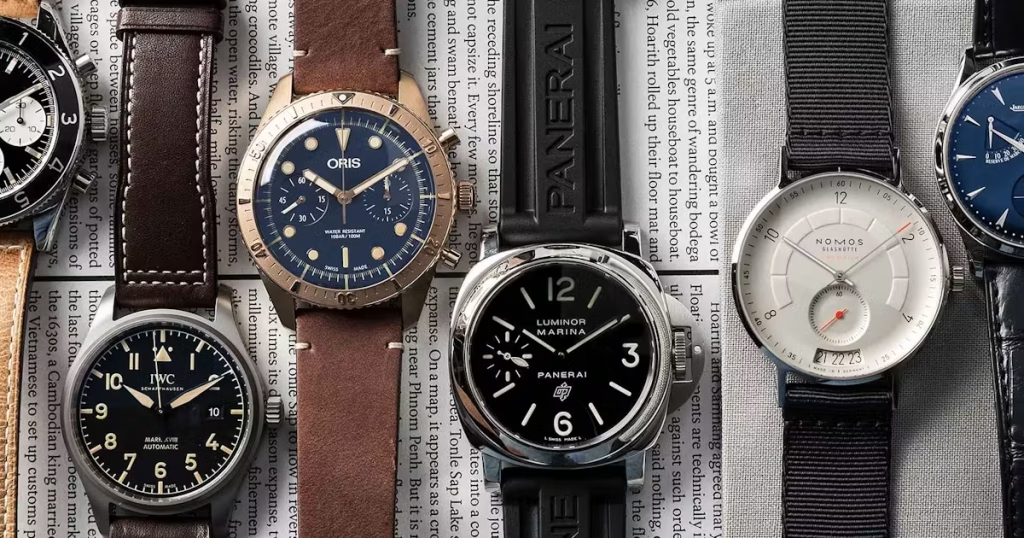The world of watches is vast and varied, from luxury timepieces crafted by iconic brands to affordable options that blend style and function. For a novice or even a seasoned enthusiast, identifying a quality watch can sometimes feel overwhelming. Fortunately, there are key indicators that help distinguish a well-crafted watch from a subpar one. By focusing on these details, you can spot a quality timepiece at first glance.
1. Examine the Materials
One of the easiest ways to identify a high-quality watch is by assessing the materials used. Premium watches typically feature stainless steel, titanium, gold, or ceramic cases. Lesser watches may use lower-grade materials like plated metals that wear down over time.
What to Look For:
- Weight: A quality watch often has a noticeable heft due to the use of solid materials. However, lightweight titanium models are an exception, offering strength without bulk.
- Finish: The case and bracelet should have a smooth, consistent finish with polished and brushed surfaces depending on the design.
2. Inspect the Movement
The movement is the heart of a watch, and its quality is a major indicator of craftsmanship. While you may not be able to see the movement in many watches, there are signs that hint at its caliber.
Types of Movements:
- Mechanical (Manual or Automatic): These are found in most high-end watches and reflect traditional craftsmanship. Look for smooth sweeping second hands and brand details about the caliber used.
- Quartz: These are typically more affordable but can still signify quality when paired with precise engineering and attention to design.
What to Look For:
- In automatic or mechanical watches, the second hand should sweep smoothly rather than tick.
- Look for certifications like COSC (Contrôle Officiel Suisse des Chronomètres), indicating a chronometer-grade movement.
3. The Crystal: Sapphire is King
The material covering the dial, known as the crystal, is another key indicator of quality. High-end watches almost always use sapphire crystal for its scratch resistance and superior clarity, while less expensive options might use mineral glass or acrylic.

How to Identify:
- Sapphire crystal has a distinct shine and often feels cooler to the touch.
- Some brands add anti-reflective coatings, which reduce glare and enhance visibility.
4. Check the Dial Details
The dial is the face of the watch, and its craftsmanship speaks volumes about its overall quality. High-end watches have meticulously designed dials with flawless finishes, sharp printing, and intricate details.
Key Features to Notice:
- Markers and Indices: They should be perfectly aligned and cleanly applied. In luxury watches, these elements are often made of metal or even luminescent material.
- Logo: The brand logo should be crisp, balanced, and proportional. Any signs of uneven printing or poor placement are red flags.
- Hands: High-quality watches have hands that are perfectly shaped and often polished or heat-treated.
5. Observe the Caseback
A watch’s caseback can provide subtle clues about its quality. While not always visible at first glance, turning the watch over often reveals additional details.
What to Look For:
- Exhibition Casebacks: Many luxury watches showcase their movements through a sapphire crystal caseback, offering a glimpse into their intricate mechanisms.
- Engravings: High-end watches often have detailed engravings on the caseback, including serial numbers, water resistance ratings, and branding.
6. Feel the Bracelet or Strap
The bracelet or strap can say a lot about a watch’s quality. A poorly made strap can ruin the experience, no matter how good the case or movement is.
What to Inspect:
- Bracelet Links: Stainless steel bracelets should feel solid and move smoothly without rattling. Hollow or sharp-edged links are signs of lower quality.
- Straps: Leather straps should be genuine and well-stitched. Check for even edges and comfortable backing material.
- Clasp: Quality watches often feature deployant clasps or well-engineered buckles with smooth operation.
7. Pay Attention to the Bezel
The bezel isn’t just an aesthetic component—it also reveals the watch’s purpose and quality. For dive watches, GMTs, or chronographs, the bezel serves functional roles, and its construction should match the watch’s overall craftsmanship.
What to Look For:
- Smooth Rotation: A rotating bezel should turn smoothly and click into place with precision.
- Material: High-end bezels may use ceramic, which is scratch-resistant and retains its color over time.
8. Brand Reputation and History
While a watch’s brand alone doesn’t guarantee quality, certain names are synonymous with superior craftsmanship. Brands like Rolex, Patek Philippe, Omega, and Audemars Piguet have long-standing reputations for excellence.
Consider These Factors:
- Does the brand have a history of horological innovation?
- Are they known for producing their own movements in-house?
- Do they have certifications or partnerships with respected organizations?
9. Water Resistance

Water resistance is not just for divers. Even dress watches benefit from some level of water resistance, which speaks to the watch’s durability and build quality.
What to Look For:
- Water-Resistance Ratings: Most quality watches have a minimum water resistance of 30 meters, with sports models going up to 100 meters or more.
- Check for screw-down crowns, which enhance water resistance.
10. The Price-to-Quality Ratio
Quality watches don’t always come with a luxury price tag. Many mid-range brands like Seiko, Tissot, and Hamilton offer excellent craftsmanship at more accessible prices. However, be wary of watches that seem too cheap for the features they claim to offer, as they may cut corners in critical areas.
Key Tip:
Research the price range for specific brands and models. A quality watch often aligns with its price, reflecting the materials, movement, and craftsmanship involved.
Conclusion
Spotting a quality watch at first glance is about paying attention to the small details. From the choice of materials and the craftsmanship of the dial to the movement and brand reputation, every element plays a part in the overall value of a timepiece. By knowing what to look for, you can confidently evaluate watches and make informed decisions, whether you’re investing in a luxury piece or selecting a reliable everyday companion.
A quality watch is more than a tool—it’s a testament to artistry, engineering, and enduring style. Keep these tips in mind, and you’ll be well-equipped to recognize excellence the moment you see it.

